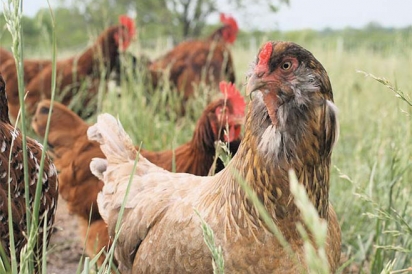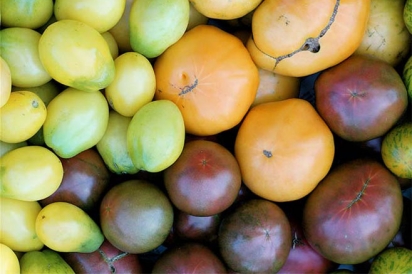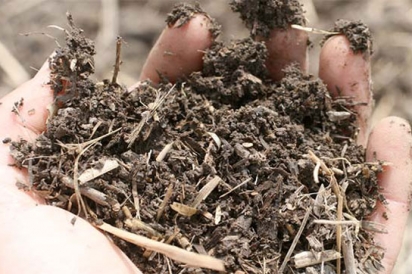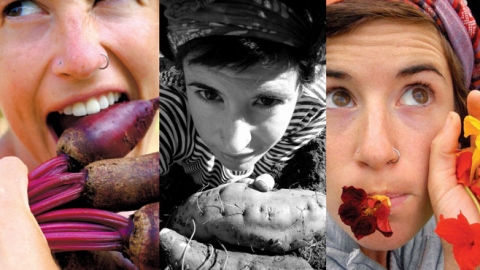Talk Dirty to Me: On Protecting Backyard Hens, Seed Saving, Tomato Secrets, “Road Apples”
I’ve got some backyard hens that I keep for company and eggs. I’ve got a completely enclosed area to protect them at night, but I’m still having trouble keeping predators out. A friend suggested getting a couple guinea hens as “guard birds”. Do you think this would help?
– Anne, Waldo
Whether you keep chickens in the city or chickens in the countryside, predators are always an issue…especially at night. On our 13 acre urban property we have problems with hawks, owls. raccoons, and stray dogs. Thanks to a solar-powered ‘automatic chicken-coop door’ my hens are safely shut in a secure house at night and we have had very few losses as a result. The hens file in at dusk (on their own accord!) and the door which is set on a timer automatically shuts behind them and opens at dawn. The house itself is sturdy & predator— proof. All vented areas are covered with hardware cloth since flimsier material like chicken wire can be ripped open by vicious raccoons. We have a “guard goose” who patrols during the day, but they can be very noisy and I don’t recommend them for neighborhood settings. Like geese, guinea fowl are said to make quite a racket when foreigners break into the coop. However, if you weren’t there to hear the ruckus your hens and your guineas would fall prey. If nighttime predators are your issue, then keeping your chickens securely closed-up in a house (not just an enclosed yard) is your best bet. Good luck Anne!
I would like to save some of the seeds from my produce this year to plant in next years garden. Do you have any suggestions on how I should go about that? Are some plants more likely to be successful than others?
– Estelle, NKC
Seed saving is a wonderful hobby and can be incredibly rewarding. Although it isn’t difficult, the crop varieties you grow are very important since only heirloom & open-pollinated seed will produce true to type off-spring. If you were to save the seeds from a hybrid tomato for instance, you would end up growing one of the parent varieties which could differ greatly from the actual tomato you saved the seed from. Fruits are the most obvious crops to save seeds from (think tomatoes, peppers, squash, melons, pumpkins, etc.) because the seeds are inside when you harvest and become a by-product of eating the food you grow. Vegetables on the other-hand are a bit more challenging. If you let your lettuce heads go to seeds for example, you’d miss-out on eating them! When saving the seeds from squash and pumpkins, simply harvest ripe (or preferably over-ripe) fruits and cut them length-wise and remove the seeds. Rinse them in a strainer and allow them to dry-out completely before storing them in clean, air-tight containers. Bear in mind that squash can easily cross-pollinate so you’d want to be sure that differing varieties were spaced far enough apart in the garden or each plant was manually pollinated.
Beans should be allowed to fully mature and left to dry-out on the plant. Remove the dry pods and break them open and allow beans to fully dry-out (the top of the refrigerator is a good spot). A thoroughly dry bean will shatter when struck with a hammer. For extra good measure freeze bean seed for 72 hours to kill any insects hiding inside then store in a cool, dry place. Tomatoes are a bit more complicated and require a brief fermentation process. Cut a ripe, unblemished tomato in half and scoop out the pulp & seeds into a jar. Add a little water and allow to sit in a warm place, stirring occasionally, for 2 to 3 days. During the fermentation process a white mold will form on the top and the good seeds will sink to the bottom. At this point you can add a little water and pour off the murky liquid being careful not to loose your seeds at the bottom. Repeat this process several times until seeds are thoroughly cleaned. Lay out on a plate or coffee filter to dry then label & store in a cool, dry place. For more info on seed saving in general or specific crop instructions, cruise the internet. There is so much information out there!!
I love nothing better than I juicy garden tomato. I know looks aren’t everything, but year after year I end up with brown patches, misshapen fruit, and tomatoes that have split open. What secrets do I need to know to grow beautiful, tasty tomatoes? Sally – Liberty Nutrient deficiencies in the soil can cause less-than-perfect fruit with blossom end rot, unsightly patches, and malformed bodies. An excess of water can cause splitting (like a particularly heavy rain). The rain we can’t help but the soil can always be improved. As a general rule for all vegetable crops, integrate AS MUCH COMPOST AS POSSIBLE into your garden beds. For enhancing your soil for tomatoes specifically you might want to try “Mumsey’s Mix”.
To each planting hole add ½ cup of the following: 1 part bone meal, 1 part corn meal, ½ part powdered milk, ¼ part Epsom salts. The bone meal will provide phosphorous and aid in the formation of quality fruits, the powdered milk provides calcium and disease control, corn meal works as a natural fungicide, and the Epsom salts will provide magnesium. On my farm, this mix is a bit too pricey for hundreds of plants. Therefore, we simply add 5 large handfuls of compost to each planting hole with great results. For a few plants, I’d say the mix is definitely worth a shot.
My Amish grandma used to collect “road apples” (horse manure) to fertilize her petunias and her vegetable garden plants and they seemed to really flourish. Is there a place in KC to get bulk manure and what’s the best way to use it?
– Daniel, Leavenworth
Bulk horse manure can be harvested from surrounding stables. The best way to locate it is by searching Craigslist (kansascity. craigslist.org/). You’ll find advertisements for composted horse manure. It is generally free and they’ll load it for you! You’ll want to be sure not to spread fresh manure around your plants. The best way to go about it is to spread aged manure on garden beds in the late fall and plant into your fertile abyss come spring!
I’m new to the area. Just moved from California. When is the right time to plant vegetables here in the Midwest?
– Josh, KCMO
When I first started farming here in the Kansas City area, I had no idea what I was doing (having just moved back from California myself!). One of my most treasured resources was Missouri Extension’s Vegetable Planting Guide. It tells you when to plant what in both spring & fall, what varieties do best in our climate, how much to plant, plant spacing, days to maturity, etc. So awesome!! Here’s the link: extension.missouri.edu/explorepdf/agguides/hort/g06201.pdf
Send your gardening, homesteading, cooking, and “green” lifestyle questions to askbrooke@ediblekansascity.com










